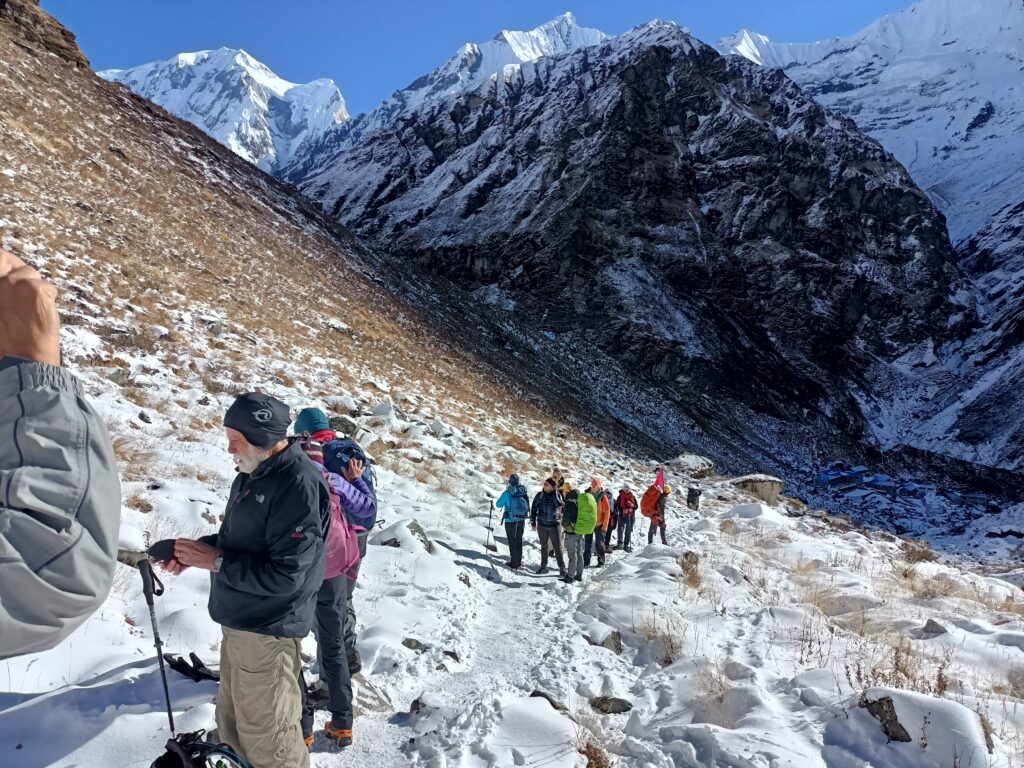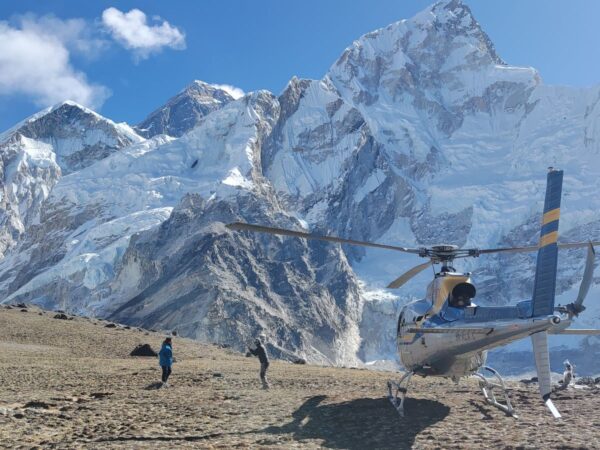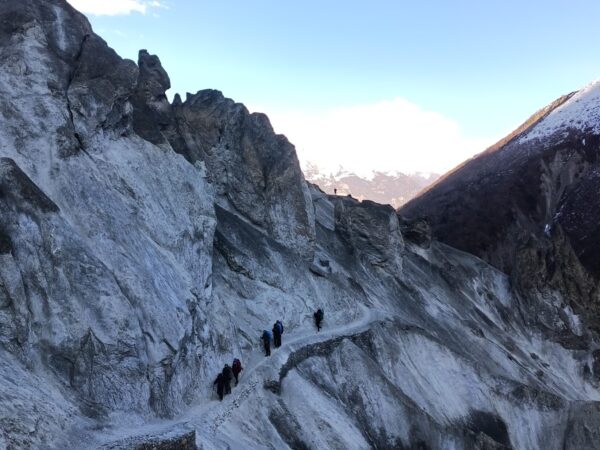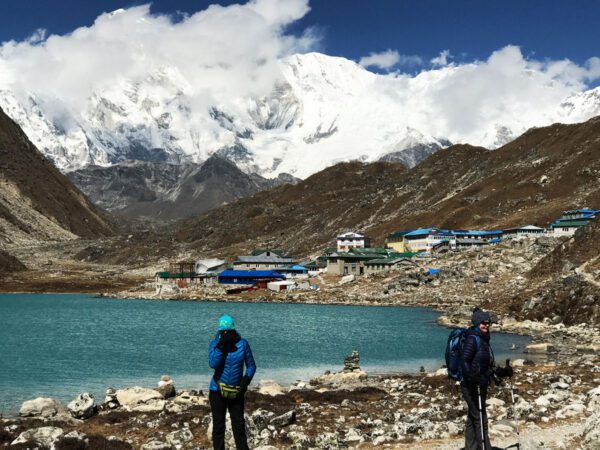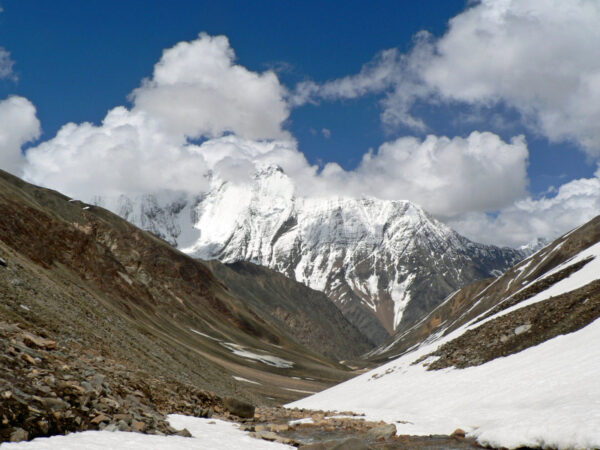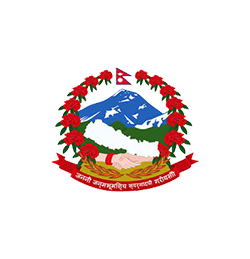Highlights
- Major monuments in Kathmandu and Pokhara are visited for sightseeing
- A multicultural community with friendly locals
- As you enter the lush Annapurna Sanctuary, lose yourself in the natural beauty of the place
- Best sunrise view and panoramic Himalayan vistas from Poonhill
- Take a break in the naturally occurring hot springs at Jhinu Danda after your hike, where the cool waters relieve tired muscles
- While trekking to ABC, take in the traditions and cultures of the Gurung, Magar, and Chhetri communities.
- Enter the Annapurna Sanctuary and experience the lushness of the surrounding wilderness
- Discover the distinctive rites and practices of communities where you may completely immerse yourself in the rich ethnic diversity, like Ghorepani, Chhomrong, Dovan, and Deurali
- The huge Himalayas in front of you, including the world's tenth-highest peak, Annapurna I (8,091m), and Annapurna Base Camp (4200m)
- In Nepal, one of the most well-liked trekking adventures
Overview
Annapurna Base Camp, also known as ABC or Annapurna Sanctuary, is the most popular trekking destination in the northwestern region of Nepal’s Annapurna area. Situated in the heart of the Annapurna Conservation Area, west of Pokhara, the base camp sits at an elevation of 4,130 meters (13,547 feet). This short trek offers stunning views of Annapurna I, the first mountain over 8,000 meters to be climbed, along with its surrounding peaks.
Beyond the breathtaking Himalayan scenery, the Annapurna Base Camp trek is known for being relatively affordable, accessible, and shorter in duration. The rich legacy of the Annapurna range and its mountaineering history add significant value to the trek. Unique among trekking routes, the ABC trek is largely forested, featuring a diverse array of flora and fauna. The journey through traditional Gurung and Magar settlements further enhances the overall trekking experience.
Best Time for the Annapurna Base Camp Trek
While the Annapurna Base Camp trek can be undertaken throughout the year, certain months offer more favorable weather conditions, making the trek easier and the views more enjoyable. The trekking experience varies significantly with each season.
Spring (March–May):
Temperature: Annapurna Base Camp temperatures range from 10°C to 0°C, with warmer temperatures in the lower regions.
Weather: Cool temperatures and almost no rainfall make for ideal trekking conditions.
Highlights: Trails are in perfect condition, and by April, the region bursts into color with red, pink, and white rhododendron blossoms.
Autumn (September-November)
Temperature: Comfortable and cool, ideal for trekking.
Weather: Clear skies and a clean environment enhance the trekking experience.
Highlights: Fantastic trail conditions, along with the festive atmosphere of Nepal’s major festivals, Dashain and Tihar, which add a vibrant cultural dimension to the trek.
Summer (June-August):
Weather: Summer coincides with the monsoon season, making trails wet and slippery.
Highlights: The rain transforms the vegetation into a lush, green blanket. Raging rivers and giant waterfalls add excitement to the trek, despite the challenging conditions.
Winter (December-February):
Temperature: Low temperatures with potential snowfall, leading to snow-covered trails.
Weather: Clear winter skies offer spectacular views of mountains and valleys.
Highlights: Though less popular, winter treks offer the thrill of navigating snowy paths and the advantage of uncrowded trails.
Accommodations:
While the tourism infrastructure in the Annapurna trek regions is basic, there is no need to camp outside unless you choose to do so.
We select the best available accommodations in the trek regions. You will typically stay in twin-sharing rooms with attached bathrooms when available, and in standard twin-sharing rooms in other locations. The lodges along the trek provide electricity, internet, and running water. Hot showers are available at an extra cost.
In Kathmandu, you have the flexibility to choose hotels based on your preferences. The city offers a wide range of hotels and lodges to suit different tastes and budgets. Most trek packages do not include accommodations in Kathmandu.
Alternative Trekking Routes in the Annapurna Region
The Annapurna region offers several alternative treks, including the Ghorepani Poon Hill Trek for stunning sunrise views, the Mardi Himal Trek for a secluded experience, and the Khayer Lake Trek for tranquil scenery. Additionally, the classic Annapurna Circuit Trek provides a comprehensive journey through diverse landscapes and cultures, while the Annapurna Circuit with Tilicho Lake Trek offers breathtaking high-altitude vistas. The Short Annapurna Base Camp Trek also provides a condensed experience of stunning mountain views. Each trek highlights the region’s natural beauty and rich culture.
Outline Itinerary
Day 1 : Arrival at Kathmandu & transfer to hotel (1350m)
Day 2 : Drive from Kathmandu to Pokhara (8,50m) Duration: 6-7 hours.
Day 3 : Drive to Nayapul & trek to Ulleri (1,960m) Duration: 5-6 hours.
Day 4 : Trek from Ulleri to Ghorepani (2,874m) Duration: 5-6 hours.
Day 5 : Hike up to Poon Hill viewpoint (3210m) & trek to Tadapani (2,710m) Duration: 6-7 hours.
Day 6 : Trek from Tadapani to Chomrong (2,170m) Duration: 6-7 hours.
Day 7 : Trek from Chomrong to Bamboo (2,600m) Duration: 5-6 hours.
Day 8 : Trek from Bamboo to Deurali (3,200m) Duration: 5-6 hours.
Day 9 : Trek to Annapurna Base Camp (4,130m) Duration: 5-6 hours.
Day 10 : Trek from ABC to Sinuwa (2,400m) Duration: 4-5 hours.
Day 11 : Trek from Sinuwa to Jhinu Danda (hot spring) (1760m) via Chomrong; Duration: hours.
Day 12 : Trek from Jhinu Danda to Nayapul & drive to Pokhara (8,20m) Duration: 6-7 hours.
Day 13 : Drive from Pokhara to Kathmandu; Duration (1,350m): 6-7 hours.
Day 14 : International departure from Kathmandu Airport.
Trekking Adventure Led by Rajan | 2022 Journey with American Senior Citizens
Annapurna Base Camp Trek – 14 Days - Itinerary
Arrival at Kathmandu & transfer to hotel (1350m)
We will pick you up from the airport and assist with your hotel check-in. You will be staying at a three-star hotel in Kathmandu. Later in the day, you will meet with the trek guide for a brief orientation session. Spend the evening preparing for the trek and exploring the vibrant streets of Thamel.
Drive from Kathmandu to Pokhara (8,50m) Duration: 6-7 hours.
Today, you'll embark on a journey to Pokhara, known as the City of Lakes. The drive promises stunning scenery, with lush hills, rocky mountains, and rushing rivers enhancing the experience. Once you arrive in Pokhara, head to your hotel and settle in.
In the evening, explore the Lakeside Market and unwind around Phewa Lake. From there, you can enjoy distant views of majestic mountains like Annapurna, Machapuchhre, Dhaulagiri, and Manaslu.
Drive to Nayapul & trek to Ulleri (1,960m) Duration: 5-6 hours.
After enjoying a delightful breakfast in Pokhara, you'll embark on a scenic drive to Nayapul, the starting point of your trek. Alternatively, you can opt for the off-road route to Hille, where your trekking adventure can begin. From Nayapul, the trail winds through verdant forests and terraced fields, following a picturesque river.
Continuing along the north bank of the Bhurungdi Khola, you'll arrive at Hille (1,495 m) before pressing onward to Tikhedhunga (1,570 m). The journey proceeds to the village of Ulleri, the next notable stop along the route.
Trek from Ulleri to Ghorepani (2,874m) Duration: 5-6 hours.
You start your trek amidst breathtaking vistas of the Annapurna Range, Mt. Hiunchuli, and Mt. Fishtail, passing through lush rhododendron forests. Along the way, you may spot wildlife such as monkeys and exotic birds. After reaching Nanghethani at 2,460 meters, a scenic hour-long walk brings you to Ghorepani village.
Nestled amid rhododendron forests and the grandeur of the Himalayas, Ghorepani offers spectacular views of the Annapurna range, Mt. Dhaulagiri, Mt. Nilgiri, Tukuche Himal, Mt. Hiunchuli, Mt. Fishtail, and more.
Hike up to Poon Hill viewpoint (3210m) & trek to Tadapani (2,710m) Duration: 6-7 hours.
Today, you'll begin early to witness one of the most breathtaking sunrises over snow-capped mountains from Poon Hill, perfect for sunrise enthusiasts. The trail from Ghorepani ascends steeply along rocky paths to reach the viewpoint.
Later, you'll trek back to Ghorepani before continuing onward to Tadapani. The route winds through verdant forests filled with rhododendrons and oak groves, passing through Deurali and Bandhani on the way to Tadapani.
Trek from Tadapani to Chomrong (2,170m) Duration: 6-7 hours.
The day starts with a hearty breakfast amidst stunning scenery. You'll trek from Ghandruk village, descending steeply to the Kimron river. As you continue, the trail climbs up to Chhomrong, where you'll settle in for the night. Along the way, you'll enjoy excellent views of Mt. Annapurna and Mt. Fishtail.
Trek from Chomrong to Bamboo (2,600m) Duration: 5-6 hours.
Descending along rugged staircases, you'll cross the Chhomrong Khola via an exhilarating suspension bridge. The path ascends from the side valley, tracing above the Modi Khola. Passing through a small settlement and diverse landscapes of bamboo, rhododendron, and oak forests, you'll navigate a challenging trail to reach Sinuwa (2,350 m).
At Sinuwa, we'll register our ACAP permit at the check post before descending via a long, steep stone staircase into a dense forest. The trail continues past muddy sections until reaching Bamboo.
Trek from Bamboo to Deurali (3,200m) Duration: 5-6 hours.
Starting from Bamboo, the trail gently climbs through thick forests up to Dovan (2,630 m). Along the way, you'll encounter several lodges and campsites, eventually merging onto a muddy trail that winds high above a river. Continuing onward leads to the Himalayan Hotel at 2,900 meters, followed by a steep ascent to Hinko Cave (3,160 m). From Hinko Cave, it's about a 20-minute walk to reach Deurali.
Trek to Annapurna Base Camp (4,130m) Duration: 5-6 hours.
After another four hours of walking, you will arrive at the Annapurna Base Camp. The valley gradually opens up, and the trail becomes less steep. As you continue trekking through the sanctuary, you'll cross two avalanche sections on a narrow path that hugs the cliffs. Upon reaching Bagar (3,310 m), follow the left side of the valley.
The trail passes by Machhapuchhre Base Camp (3,820 m), continues through the alpine meadow, and ascends to ABC. Along the way, you'll be treated to panoramic views of Annapurna South, Annapurna I, Annapurna III, Mt. Fishtail, Mt. Hiunchuli, Mt. Gangapurna, Tilicho Peak, Pisang Peak, Mt. Dhaulagiri, and more.
Trek from ABC to Sinuwa (2,400m) Duration: 4-5 hours.
After breakfast, you will trek back to Sinuwa. From there, continue your journey to the Himalayan Hotel and descend to Dovan. Trek further through the Bamboo village, passing by dense forests. The trail ascends to Kildi Ghar and returns to Sinuwa. Although much of the trail today is downhill, be sure to walk carefully.
Trek from Sinuwa to Jhinu Danda (hot spring) (1760m) via Chomrong; Duration: hours.
After descending from Sinuwa, you trek down to Chhomrong Khola and follow stone staircases for about an hour. The path then gently leads to Jhinu Danda, a village known for its natural hot springs where you can relax for the rest of the day. Access to the hot springs may require a small additional fee for enjoyment.
Trek from Jhinu Danda to Nayapul & drive to Pokhara (8,20m) Duration: 6-7 hours.
Start your day with breakfast and prepare for the final day of the trek. The trail winds down through secluded settlements and verdant forests towards Nayapul, our starting point. From Nayapul, we'll drive back to Pokhara. The rest of the day is yours to enjoy in Pokhara. Take a leisurely boat ride on the serene Phewa Lake and unwind.
Drive from Pokhara to Kathmandu; Duration (1,350m): 6-7 hours.
At 6 am, your guide will meet you for an early morning departure to the bus park, where you'll board a tourist bus bound for Kathmandu. Alternatively, private car or flight arrangements can be made upon request, with additional costs applicable.
Scenic Nepal Treks will organize a farewell dinner at a Nepalese cuisine restaurant, offering an authentic experience of local dishes and live traditional dances.
International departure from Kathmandu Airport.
Our team at Everest Hikes will accompany you to the airport for your return flight. You also have the option to experience Mountain Flights, offering stunning views of the Everest region. Afterward, we will arrange your transfer to the International Airport for your departure. Please ensure you arrive at the airport at least 3 hours before your scheduled flight
Inclusions
What's included
- International & Domestics Airport pick up and drop
- Standard Hotel accommodation in Kathmandu & Pokhara (with breakfast included)
- An Experience English speaking guide and porter (1 porter for every 2 trekkers)
- All Meals and Teahouse accommodation during the trek
- Kathmandu - Pokhara - Kathmandu by tourist bus
- Pokhara - Nayapul - Pokhara by Private vehicle
- All required trekking permits (Annapurna Conservation Area Entry Fee and TIMS Card)
- Guide and porter insurance with food and accommodation
- Basic Medical kits
- Sleeping and duffel bag, down jacket, trekking poles (should be returned after the trek
- Farewell dinner
- Emergency Helicopter Evacuation Service Arrangement Only (should cover by your travel insurance)
- All required paper works and government taxes
- Everest Hikes T-shirt
What's not included
- International Flight
- Nepal Travel Visa Fee
- Personal Medical and Travel insurance (Should cover helicopter evacuation)
- Guide, Porter and Driver tips
- Personal Gears (equipment)
- Personal bill
- Lunch and Dinner in Kathmandu
- All other personal expense of beverages (hard and soft drinks)
- All other things not mentioned in the inclusion
Equipment
Recommended Trekking Gears
Clothing
- Base Layers (Moisture-Wicking)
- Thermal tops and bottoms (polyester or merino wool)
- Lightweight long-sleeve shirts
- Insulating Layers
- Fleece jacket or pullover
- Down jacket (for high-altitude treks)
- Warm sweaters
- Outer Layers (Shells)
- Waterproof and windproof jacket (Gore-Tex or similar)
- Waterproof pants
- Trekking Pants
- Quick-dry pants
- Convertible hiking pants (zip-off into shorts)
- Trekking Shirts
- Lightweight and breathable T-shirts
- Long-sleeve shirts with UV protection
- Headwear
- Wide-brim hat or cap for sun protection
- Warm beanie for cold temperatures
- Buff or scarf for dust and wind
- Gloves
- Lightweight trekking gloves
- Insulated gloves for higher altitudes
- Socks
- Moisture-wicking trekking socks
- Thermal socks for colder regions
- Footwear
- Sturdy and waterproof trekking boots (well broken-in)
- Comfortable sandals or camp shoes (for evenings/rest days)
- Gaiters (optional, for snow or muddy trails)
Backpacks & Bags
- Backpack
- 40-50L capacity for multi-day treks
- Comfortable straps and rain cover
- Daypack
- 20-30L for short treks or carrying essentials during the day
- Duffel Bag
- Used if porters are carrying your gear (for organized treks)
- Dry Bags
- To keep electronics and clothes dry in wet conditions
Sleeping Gear
- Sleeping Bag
- 4-season sleeping bag (rated for -10°C to -20°C for high-altitude treks)
- Sleeping bag liner (optional, for extra warmth and hygiene)
- Sleeping Pad (if camping)
- Lightweight and inflatable or foam pads for comfort
Trekking Accessories
- Trekking Poles
- Adjustable and lightweight poles (essential for steep ascents/descents)
- Water Bottle/Hydration System
- Insulated bottle (to prevent freezing at high altitudes)
- CamelBak or similar hydration reservoir
- Water Purification
- Water filters, purification tablets, or UV sterilizers
- Sunglasses
- UV protection (Category 3 or 4 for snowy conditions)
- Headlamp
- With spare batteries (essential for early morning or late-night treks)
- Multi-tool or Knife
- For various small tasks
- First Aid Kit
- Bandages, blister patches, antiseptic wipes, painkillers, Diamox (for altitude sickness), etc.
- Lip Balm
- SPF-protected to prevent chapping
- Sunscreen
- High SPF for UV protection at higher altitudes
- Personal Toiletries
- Biodegradable soap, toothpaste, toothbrush, quick-dry towel, wet wipes, and toilet paper
Optional but Useful Items
- Camera
- To capture the stunning scenery (extra batteries and memory cards are a must)
- Snacks
- Energy bars, trail mix, or chocolate for quick energy boosts
- Power Bank/Solar Charger
- For charging devices in remote areas
- Books or E-Readers
- For downtime during rest days
- Earplugs
- To block out noise in lodges or camps
- Notebook/Journal
- To record your trek experience
Clothing Packing Tips
- Layering is key: It helps regulate your body temperature and adapt to changing weather.
- Avoid cotton: It retains moisture and dries slowly, which can lead to discomfort or hypothermia.
- Pack light: Only carry what is absolutely necessary to avoid unnecessary weight.
Gear Rentals in Nepal
If you're worried about carrying too much gear, trekking hubs like Kathmandu and Pokhara offer trekking equipment rentals and sales. You can find items like sleeping bags, down jackets, and trekking poles at reasonable prices. However, ensure you check the quality before renting.

